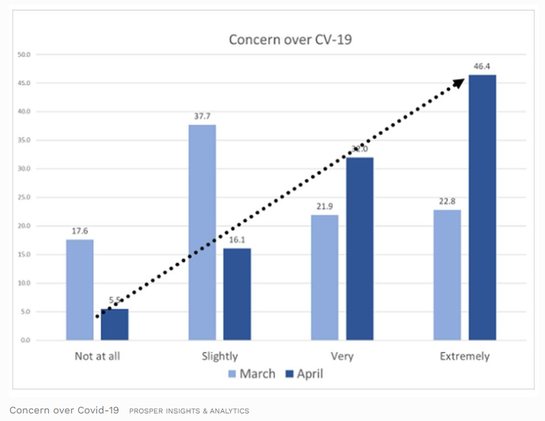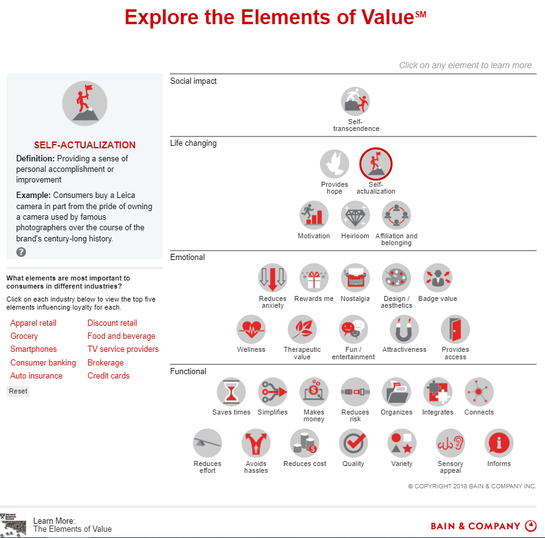Why AdRoll is Your Ideal Programmatic DSP
AdRoll helps you run full-funnel, multi-channel ad campaigns. Learn how our programmatic DSP enables better ad campaigns that convert customers.
Read More
When a crisis hits, advertisers suddenly find themselves in uncharted waters, and confusion abounds. What’s the best way to talk to customers about sensitive topics? What constitutes a claim? No brand wants to rub customers the wrong way with a tone-deaf ad, or worse, find themselves facing a PR disaster. Here are some of the dos and don’ts that brands should take aboard when considering how to implement ads during a crisis.
During a national emergency or global crisis, sensitivities are high. According to survey data by Prosper, consumer concern over COVID-19 increased significantly as the crisis deepened during March and April 2020.
Image: Forbes
In response, the networks clamped down on ads that could be seen as exploitative. For example, many platforms — including major ones like Google and Facebook — banned ads for face masks. This was to prevent businesses from capitalizing on the massive surge in demand and to avoid any hint of profiteering.
One of the most important ways that advertisers can maintain brand integrity is by showing sensitivity to the needs and feelings of customers. This is true at all times, but particularly so during a crisis. A brand that appears to be going after profits rather than working towards the greater good will not come out of a crisis untarnished.
Ad tip #1: Think of consumers as real individuals, who are concerned about their families and homes. Be attuned to consumer sentiment, and tread carefully. If necessary, completely avoid taboo topics or themes.
The last thing a brand wants to do in times of uncertainty is to add to the sense of mass panic. In a recent sentiment survey of 6,000 consumers, 58% said that brands get good marks for keeping customers safe, and 32% said that reassuring communications lead to positive sentiments towards a brand.
Rather than mirroring the consumer’s natural sense of confusion and fear, brands should use ads during a crisis to provide a confident, reassuring boost. Never employ scare tactics — the aim is to create positive emotional experiences, as this will reinforce positive feelings towards the brand. For example, the commonly used “Limited supply” might be fine in normal times, creating a sense of urgency for the customer. However, in an emergency situation, these same words will only cause stress and discomfort.
Ad tip #2: In a crisis, avoid using copy or images that escalate legitimate fear or panic. Steer clear of scary phrases, such as “Stocks are low” or “Last chance.” Instead, use language that’s uplifting and reassuring.
Read more about our data-driven ad copy best practices:
Even in a crisis, life continues. People still need to eat, sleep, be entertained, and communicate with one another. Especially when an emergency situation is ongoing, people tend to adjust eventually to the new circumstances, as the initial shock reactions wear off. They don’t need to be continually reminded of the dangers that are lurking. Rather than focusing on the emergency, brands will do better if they focus on providing a coherent, relevant message.
According to Neil Patel, showing irrelevant images in online ads is one of the main reasons why users bounce off landing pages. If a brand mentions the crisis in an ad, only to bring the customer to a generic landing page that contains no relevant or useful crisis-related content, that’s called clickbait. This often results in customers losing interest and clicking away.
Ad tip #3: If referencing the crisis in an ad, make sure any linked content accurately reflects the ad message. If ads lack coherence, consumers simply won’t engage, especially during a crisis when they are looking for relevant information and offers.
The issue of claims in advertising is a legal and ethical quagmire. In 2014, Red Bull settled a $13 million class-action suit for promoting the slogan “Red Bull gives you wings,” on the grounds that it doesn’t in fact give anyone wings nor improve their reaction times or concentration abilities. Seemingly harmless puns and phrases can be dangerous in advertising. False claims, even if unintentional, can lead to a costly scandal, not just in financial terms, but in brand perception, too.
Ads during a crisis should steer completely clear of any claims of medical, life-saving, or health-boosting effects, avoid implying any associations with government bodies, never contradict public health and safety guidelines, and avoid claims for any type of preventions or cures.
Ad tip #3: Especially during a crisis, it pays to be extra careful to not make any statement that could be construed as a false claim. Check and double-check all ad content, and see that it is measured and substantiated.
The success of a brand depends on the value it provides to its customers. Not just monetary value, such as affordable products, but also the ways that the brand meets the customer’s fundamental needs. Bain & Co famously identified 30 “building blocks” of consumer value, which can be explored in this interactive pyramid diagram:
Image: Bain & Co.
In a challenging situation, don’t ignore the facts on the ground, but don’t overkill either. Rather, create ads that focus on meeting consumers’ needs, whether it be a functional need (ie. providing helpful information), or an emotional one (ie. reducing anxiety). For example, Lay’s, the potato chip brand, promoted its “Joygivers” ad during the coronavirus, showcasing the real-life ways people are bringing joy to each other during a difficult time. Rather than talking about potato chips, Lay’s ad fulfills the consumer’s need for hope, togetherness, and entertainment.
Ad tip #5: During an emergency or crisis, consumers tend to go back to the fundamentals of life, like family, health, and hope. Make those the star of the brand ads.
One of the biggest challenges for advertisers is staying on top of all the different requirements and rules of the various ad networks. During a crisis, many networks institute stringent guidelines, only to change them as events unfold. What was acceptable to include in an ad on one particular day, may well be banned the day after.
For instance, at the start of the pandemic, Google banned coronavirus-related ads. However, these restrictions were relaxed later on, but only for ads provided by “authoritative sources." Other platforms underwent similar changes of heart as the crisis panned out.
Getting ads rejected is a drain on the advertiser’s time and resources, especially during a crisis when both are in even shorter supply. Keeping up with advertising rules across all relevant platforms can save brands time and money.
Ad tip #6: During challenging times, be prepared for sudden changes to rules and requirements on ad networks. Depending on the nature of the emergency, the rules may shift rapidly, so it pays for brands to stay aware of any changes.
For more on how to keep on top of trends for ads during a crisis:
In an emergency, the “situation” is naturally the number one topic of conversation. In the past few months, Google searches for coronavirus-related topics saw a massive surge, well ahead of other highly popular searches. This may seem like a honey pot for advertisers, who are naturally tempted to go full swing ahead and gain exposure with ad campaigns focused on the crisis. The wise response would be: “not so fast.” Particularly during a crisis, brands need to slow down, take a deep breath, and focus on laser-sharp messaging and tactics that will help carry the brand to the other side — not just intact, but in better shape than ever before.
Last updated on April 23rd, 2025.

